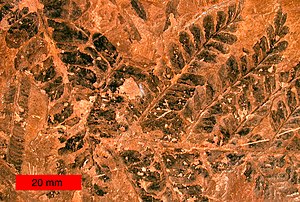
A compression fossil is a fossil preserved in sedimentary rock that has undergone physical compression. While it is uncommon to find animals preserved as good compression fossils, it is very common to find plants preserved this way. The reason for this is that physical compression of the rock often leads to distortion of the fossil.
The best fossils of leaves are found preserved in fine layers of sediment that have been compressed in a direction perpendicular to the plane of the deposited sediment.[1] Since leaves are basically flat, the resulting distortion is minimal. Plant stems and other three-dimensional plant structures do not preserve as well under compression. Typically, only the basic outline and surface features are preserved in compression fossils; internal anatomy is not preserved. These fossils may be studied while still partially entombed in the sedimentary rock matrix where they are preserved, or once lifted out of the matrix by a peel or transfer technique.[2]
Compression fossils are formed most commonly in environments where fine sediment is deposited, such as in river deltas, lagoons, along rivers, and in ponds. The best rocks in which to find these fossils preserved are clay and shale, although volcanic ash may sometimes preserve plant fossils as well.[3]
- ^ Cite error: The named reference
Arnold 1947was invoked but never defined (see the help page). - ^ Cite error: The named reference
Stewart 1993was invoked but never defined (see the help page). - ^ Cite error: The named reference
Taylor & Taylor 1993was invoked but never defined (see the help page).